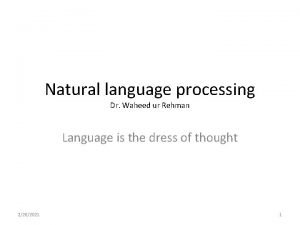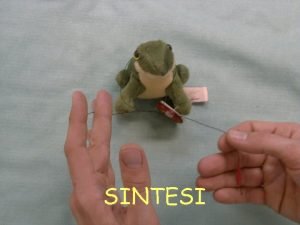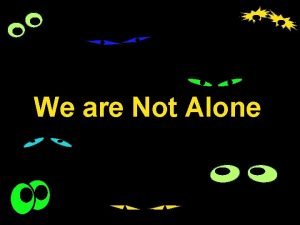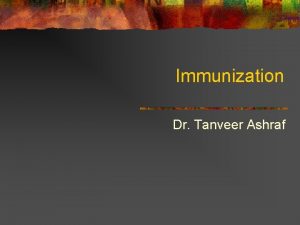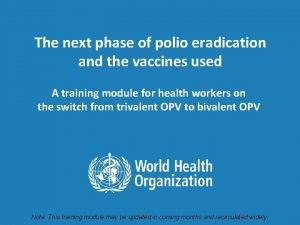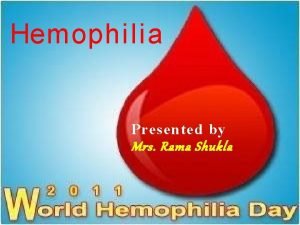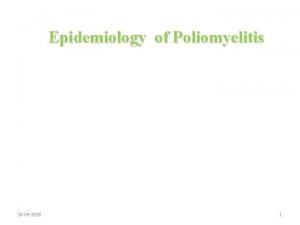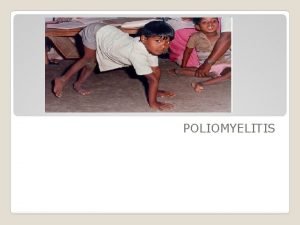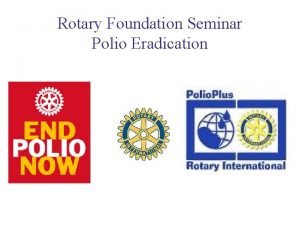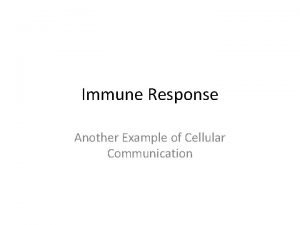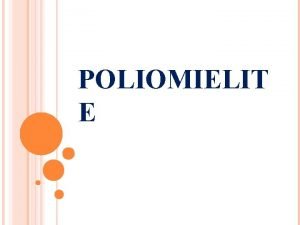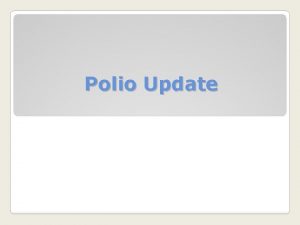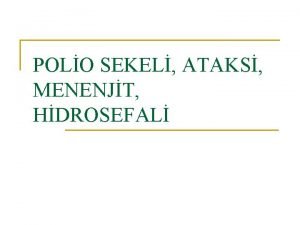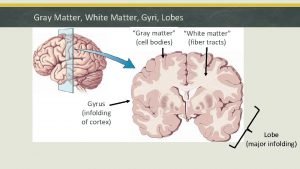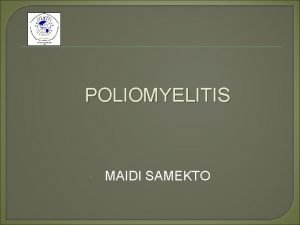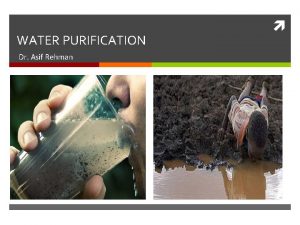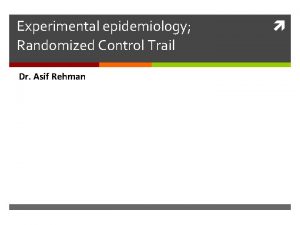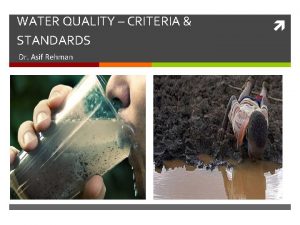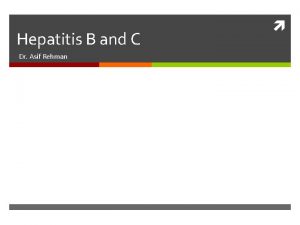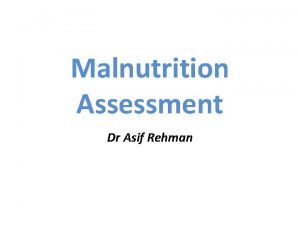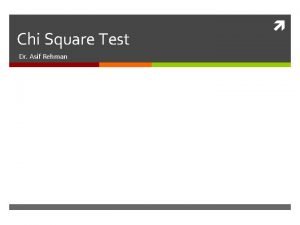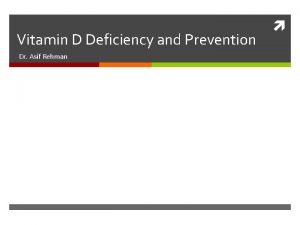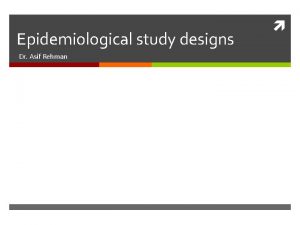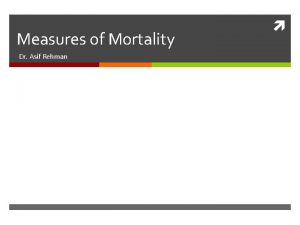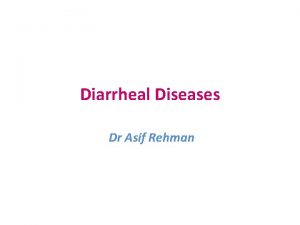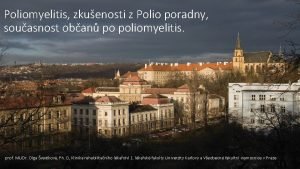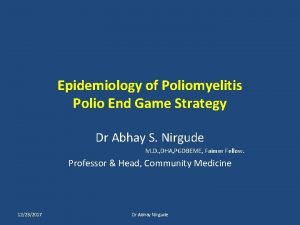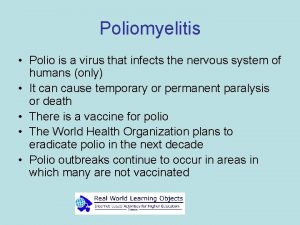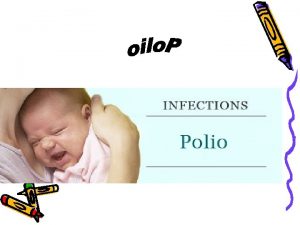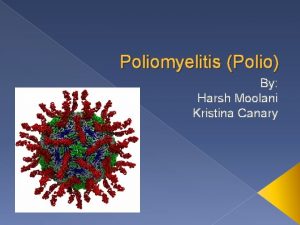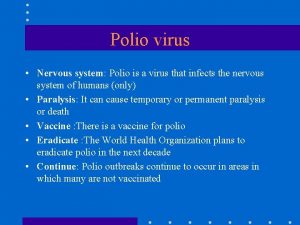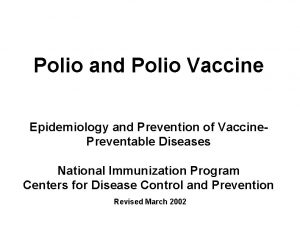Poliomyelitis Dr Asif Rehman Poliomyelitis Polio gray matter































- Slides: 31

Poliomyelitis Dr. Asif Rehman

Poliomyelitis Polio= gray matter Myelitis= inflammation of the spinal cord This disease result in the destruction of motor neurons caused by the poliovirus. Poliovirus attacks the nerve cells of the brain & spinal cord although not all infections result in sever injuries and paralysis.

History In the early 20 th century, polio was one of the most feared diseases in industrialized countries, paralyzing hundreds of thousands of children every year. However, soon after the introduction of effective vaccines in the 1950 s and 1960 s, polio was brought under control and practically eliminated as a public health problem in these countries Lameness surveys during the 1970 s revealed that the disease was also prevalent in developing countries. As a result, during the 1970 s, routine immunization was introduced worldwide as part of national immunization program, helping to control the disease in many developing countries

History In 1988, when the Global Polio Eradication Initiative began, polio paralyzed more than 1000 children worldwide every day. Since then, more than 2. 5 billion children have been immunized against polio thanks to the cooperation of more than 200 countries and 20 million volunteers, backed by an international investment of more than US$ 11 billion.

Key Facts Polio (poliomyelitis) mainly affects children under 5 years of age. 1 in 200 infections leads to irreversible paralysis. Among those paralyzed, 5% to 10% die when their breathing muscles become immobilized. Polio cases have decreased by over 99% since 1988, from an estimated 3, 50, 000 cases then, to 74 reported cases in 2015. The reduction is the result of the global effort to eradicate the disease. As long as a single child remains infected, children in all countries are at risk of contracting polio. Failure to eradicate polio from these last remaining strongholds could result in as many as 2, 00000 new cases every year, within 10 years, all over the world. In most countries, the global effort has expanded capacities to tackle other infectious diseases by building effective surveillance and immunization systems.

Key Facts Polio is considered one of the most feared diseases. In the early 1950 s, before polio vaccines were available, polio outbreaks caused more than 15, 000 cases of paralysis each year in the United States. Following introduction of vaccines—specifically, trivalent inactivated poliovirus vaccine (IPV) in 1955 and trivalent oral poliovirus vaccine (OPV) in 1963—the number of polio cases fell rapidly. It takes only one traveler with polio to bring the disease into a country. The best way to keep a country polio-free is to maintain high immunity (protection) in the population against polio through vaccination

Key Facts Of the 3 strains of wild poliovirus (type 1, type 2, and type 3), wild poliovirus type 2 was eradicated in 1999 and case numbers of wild poliovirus type 3 are down to the lowest-ever levels with the no cases reported since a case reported by Nigeria in November 2012. Once polio is eradicated, the world can celebrate the delivery of a major global public good that will benefit all people equally, no matter where they live. Economic modelling has found that the eradication of polio would save at least US$ 40– 50 billion between 1988 and 2035, mostly in low-income countries. Most importantly, success will mean that no child will ever again suffer the terrible effects of lifelong polio-paralysis.

Causative Organism Poliovirus: belongs to “Picorna” viruses which are small RNA-containing viruses. Polioviruses have three antigenically distinct types, giving no cross immunity: a) b) c) Type I: “Leon”; the commonest in epidemics Type II: “Berlinhide”; the prevailing type in endemic areas. Type III: “Lansing”; occasionally causes epidemics. Polioviruses are relatively resistant and survive for a long time under suitable environmental conditions, but are readily destroyed by heat (e. g. pasteurization of milk, and chlorination of water.

Mode of Transmission poliomyelitis spreads by two routes: 1. Oral-oral infection: direct droplet infection 2. Faeco-oral infection Polio virus has the ability to survive in cold environments. Overcrowding and poor sanitation provide opportunities for exposure to infection. People who don’t have symptoms can still pass the virus to others and make them sick.

Transmission

Symptoms Most people who get infected with poliovirus (about 72 out of 100) will not have any visible symptoms. About 1 out of 4 people with poliovirus infection will have flu-like symptoms that may include— Sore throat Fever Tiredness Nausea Headache Stomach pain These symptoms usually last 2 to 5 days then go away on their own.

Symptoms A smaller proportion of people with poliovirus infection will develop other more serious symptoms that affect the brain & spinal cord: Paresthesia (feeling of pins and needles in the legs) Meningitis (infection of the covering of the spinal cord and/or brain) occurs in about 1 out of 25 people with poliovirus infection Paralysis (can’t move parts of the body) or weakness in the arms, legs, or both, occurs in about 1 out of 200 people with poliovirus infection Paralysis is the most severe symptom associated with polio because it can lead to permanent disability & death. Between 2 out of 100 people who have paralysis from poliovirus infection die because the virus affects the muscles that help them breathe. Even children who seem to fully recover can develop new muscle pain, weakness, or paralysis as adults, 15 to 40 years later. This is called postpolio syndrome. Note that "poliomyelitis defined as the paralytic disease. So only people with the paralytic infection are considered to have the disease.

Polio Eradication Polio is a crippling and potentially fatal infectious disease. There is no cure, but there are safe and effective vaccines. Therefore, the strategy to eradicate polio is based on preventing infection by immunizing every child to stop transmission and ultimately make the world polio free. In 1988, the World Health Assembly adopted a resolution for the worldwide eradication of polio. It marked the launch of the Global Polio Eradication Initiative (GPEI), headed by national governments, CDC, Rotary International, WHO, and UNICEF, with substantial support from the Bill & Melinda Gates Foundation. Today, polio continues to circulate in three countries: Afghanistan, Pakistan &Nigeria.

Polio vaccines The oral polio vaccine builds protection in the child’s intestine. This vaccine not only protects the child who receives it, but also protects others around the vaccinated child. Several doses of the oral polio vaccine should be given to every single child in places where polio is a threat. The injectable vaccine builds protection in the blood instead of the gut. It helps to boost immunity and keeps countries free from polio, but it doesn’t stop polio spreading through children, so it is not as useful in places where virus is still circulative.

Difference between IPV and OPV IPV is Inactivated (killed) virus vaccine while Oral Polio Vaccine is a live attenuated (harmless) vaccine IPV is more effective and has less risk of side effects as virus in vaccine is already killed. It is less heat sensitive. Weak point is that it does not provide local gut immunity as OPV is to be given by mouth. Less immunogenic and therefore more doses are required. This needs efficient thermal protection. Since this vaccine is given by mouth and proliferates in intestine, it provides excellent local protection. Moreover, when excreted in stool, it makes herd immunity by feco-oral route. Both these vaccines have distinct advantages. IPV is safe and more effective but costly and in short supply.

High Risk Areas

Polio cases trend

Province wise polio case

Polio Cases in provinces

SURVEILLANCE Surveillance is one of the main pillars of the polio eradication initiative. By testing stool samples collected from children suffering from acute flaccid paralysis – the clearest symptom of the virus – as well as samples from sewage water, the program is able to identify where the poliovirus is circulating and who is being affected.

Acute Flaccid Paralysis (AFP) Surveillance AFP surveillance, or finding and reporting children with acute flaccid paralysis (AFP), is fundamental in detecting polio cases. Each case of AFP acts as a signal to the polio surveillance system that polio might be circulating.

Environmental Surveillance In addition to AFP surveillance, environmental surveillance helps enhance the sensitivity of surveillance for polioviruses. Environmental surveillance involves testing sewage or other environmental samples for the presence of poliovirus. In Pakistan, the program has used environmental surveillance to detect the poliovirus in sewage in strategic locations since 2009.

Samples from sewage water

Stool Surveys Among Healthy Children The program conducts periodic stool surveys among the children from high-risk populations which may be carrying the poliovirus without any paralytic cases or circulation which may otherwise be difficult to detect through regular AFP surveillance.

Stool survey Kit

ERADICATION STRATEGY An array of approaches and tools are implemented to help Pakistan reach the finish line of zero polio cases. These approaches and tools are outlined in the National Emergency Action Plan of the Pakistan Polio Eradication Program (NEAP) with specific objectives, targets, milestones and indicators that guide the program to its goal of zero-polio. As envisioned in the NEAP 2018, the program implement an intense vaccination schedule to ensure maximum vaccination coverage of vulnerable children.

FAQ

FAQ

FAQ


THANK YOU
 Gray matter and white matter
Gray matter and white matter What is gray matter in the brain
What is gray matter in the brain Gray matter in the brain
Gray matter in the brain Label the cranial dura septa and associated sinuses.
Label the cranial dura septa and associated sinuses. Fasih ur rehman
Fasih ur rehman Ben rehman
Ben rehman Dr waheed rehman
Dr waheed rehman Tahira rehman
Tahira rehman Abdur rahman chughtai
Abdur rahman chughtai Barrel chest
Barrel chest Amir asif
Amir asif Minahil asif
Minahil asif Trapano traduzione
Trapano traduzione Dr asıf yıldırım
Dr asıf yıldırım Asif əsgərov
Asif əsgərov Asif international
Asif international Blastomycosis
Blastomycosis Prevention and control of poliomyelitis
Prevention and control of poliomyelitis Types of poliomyelitis
Types of poliomyelitis Poliomyelitis
Poliomyelitis Conclusion of malaria
Conclusion of malaria Poliomyelitis slideshare
Poliomyelitis slideshare Tripod sign polio
Tripod sign polio Papa lolos
Papa lolos Post polio sundrome
Post polio sundrome Antigen attacker
Antigen attacker Syphilus
Syphilus Poliomielit
Poliomielit What is polio disease
What is polio disease Glauc o medical term
Glauc o medical term Polio vaccine acronym
Polio vaccine acronym Dismetri
Dismetri






